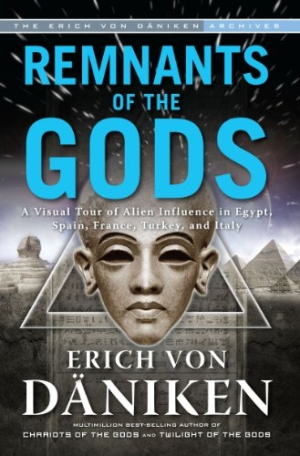Remnants of the Gods
A Visual Tour of Alien Influence in Egypt, Spain, France, Turkey, and Italy
Persuasive and engaging arguments support a suggestion of alien influence in our archaeological history.
Even casual readers of books about aliens and UFOs will have heard the name Erich von Däniken. Since 1968’s Chariots of the Gods, he’s been recognized as the authoritative voice on theories about prehistoric alien influence. He’s written several overlapping books on the subject, of which Remnants of the Gods: A Visual Tour of Alien Influence in Egypt, Spain, France, Turkey, and Italy is the latest.
Von Däniken examines a side of history and human development he considers blatantly and purposefully ignored by mainstream science. He says there are, in various tombs, caves, and other structures, numerous examples of geometric precision and planning well beyond the scientific knowledge of the time. These structures left over from antiquity, from Stonehenge to the pyramids, he says, show evidence of superhuman extraterrestrial visitors.
Von Däniken is a persuasive writer, engaging throughout, and his research is shown in a reasonable and orderly manner. He points out intriguing contradictions in what we know of prehistory. The inflammatory, illogical, and downright paranoid rhetoric of many UFO theorists is all but absent in his writing. Aside from occasionally preachy pronouncements, railing against what he sees as the cowardice of mainstream science, Von Däniken’s voice is that of a curious and imaginative archeology student.
Von Däniken is an expert in asking “why” and “who,” if not necessarily in answering “how.” Why, for example, is there a line beginning in northern France, running down to southern Italy, along which numerous towns—Calais, Alix, Alet, Alaise, among others—have very similar names? It is indeed a strange occurrence. Another question: who really built the pyramids? Modern understanding is that Cheops commissioned them, though Von Däniken, quite persuasively, asserts that no records contemporaneous with the pyramids themselves can back this assertion. He offers instead that according to some ancient historians, the pyramids were built by Saurid, an Egyptian counterpart for Hermes. And as far as Von Däniken is concerned, mention of gods equals aliens.
Does either the line of towns or the architecture of pyramids instantly imply aliens? No. But they fit as a part of his larger view, which includes many other examples of seemingly coincidental organization on a scale he finds too grand and precise to have been accomplished by the sciences of the time. As he puts it, “incomprehensible facts lie below everyone’s feet, so to speak, which do not fit into any conception of history or archeology textbook.”
The book’s numerous illustrations are a useful addition to the text, though sometimes the layout of photos in relation to the text feels clumped and haphazard. Still, it’s an intriguing study overall. Whether the reader is a believer in aliens or not, he or she will find curiosities enough to remain interested.
Reviewed by
Jason Henninger
Disclosure: This article is not an endorsement, but a review. The publisher of this book provided free copies of the book to have their book reviewed by a professional reviewer. No fee was paid by the publisher for this review. Foreword Reviews only recommends books that we love. Foreword Magazine, Inc. is disclosing this in accordance with the Federal Trade Commission’s 16 CFR, Part 255.

